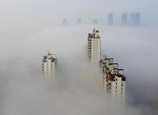
Experts believe that in addition to unfavorable weather conditions, the roots of the smog are industrial emissions, vehicle exhausts and dust from construction sites.
In 2011, China announced that it has met its major air and water pollution control targets for the country's 11th Five-Year Plan (2006-2010) and set even more ambitious reduction goals for the following five years.
However, the prolonged smog these past days indicates that as China's industrialization and urbanization is stepping forward, the environmental situation facing the country will be increasingly challenging and counter-pollution control work will be arduous and require more vigorous, effective and scientific measures.
There is no reason to be too optimistic.
In addition to policies to curb the pollution sources, the bleak weather also tested the government's emergency response capabilities.
Beijing issued the city's first orange fog warning -- the second most severe level in China's four-tier color-coded weather warning system -- on Sunday morning due to decreased visibility. Similar measures were also launched in other cities.
However, some media reports claimed that most primary and secondary schools in Beijing were not informed by authorities to stop students' outdoor activities, as is suggested in the emergency plan for serious pollution.
It should also be noted that curbing pollution and protecting the environment are not the government's exclusive obligations. Citizens ought to do their share, through approaches such as more frequent use of public transport.
The weekend smog in Beijing is reminiscent of the Great Smog of London in 1952, which was believed to have resulted in the premature deaths of at least 4,000 people, a heavy cost for prosperity in the industrialization progress.
But London is no longer the "city of fog," thanks to enhanced governmental regulations and public awareness.
China should learn from its experiences, but avoid duplicating its failure.


















 The strongest left-behind children: 9-year-old girl holds up a family
The strongest left-behind children: 9-year-old girl holds up a family


![]()
